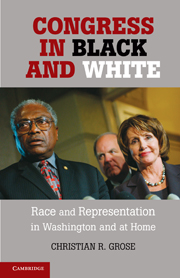Book contents
- Frontmatter
- Contents
- List of Figures and Tables
- Acknowledgments
- 1 African-American Legislators, African-American Districts, or Democrats?
- 2 A Unified Theory of African-American Representation in Congress
- 3 The “Hollow Hope” of Civil Rights Change in the U.S. House
- 4 Location, Location, Location
- 5 Constituency Service in the District
- 6 Bringing Home the Bacon
- 7 The Future of Racial Redistricting
- Appendix 1 Methods Used to Measure the Civil Rights Issue Space
- Appendix 2 Methods for Qualitative Research
- Appendix 3 Data, Methods, and Models for Project Allocations to African Americans
- References
- Index
Appendix 2 - Methods for Qualitative Research
Published online by Cambridge University Press: 03 May 2011
- Frontmatter
- Contents
- List of Figures and Tables
- Acknowledgments
- 1 African-American Legislators, African-American Districts, or Democrats?
- 2 A Unified Theory of African-American Representation in Congress
- 3 The “Hollow Hope” of Civil Rights Change in the U.S. House
- 4 Location, Location, Location
- 5 Constituency Service in the District
- 6 Bringing Home the Bacon
- 7 The Future of Racial Redistricting
- Appendix 1 Methods Used to Measure the Civil Rights Issue Space
- Appendix 2 Methods for Qualitative Research
- Appendix 3 Data, Methods, and Models for Project Allocations to African Americans
- References
- Index
Summary
In Chapters 4 and 5, the dependent variable is constituency service allocations to African-American constituents. Most of the analyses in Chapters 4 and 5 come from a qualitative sample of districts. I interviewed twenty-seven district staff members of legislators in seventeen districts during the 106th and 107th Congresses (visiting twenty-seven total district offices). Interviews in three of these districts were conducted jointly with political scientists Maurice Mangum and Christopher Martin. Through interviews and participant observation during these visits, I have gathered data and qualitative evidence on these district offices and these seventeen members of Congress. See Table 4.1 in Chapter 4 for a list of members whose district offices I visited, broken down by relevant independent variables (this qualitative sample was selected based on variation in the independent variables; see King, Keohane, and Verba 1994). The selection of these districts was not random, but was done scientifically in order to vary the independent variables of interest. More on this subject is detailed later. I rely on this field research to illuminate the results throughout the book as well.
Methodological issues are not just the realm of quantitative research. Whereas issues plaguing quantitative research are different from those in qualitative small-n research, the issues in qualitative research are often stickier and deal with more fundamental questions of research design. Through small sample studies, we can learn much more about the context of representation in the district.
- Type
- Chapter
- Information
- Congress in Black and WhiteRace and Representation in Washington and at Home, pp. 193 - 196Publisher: Cambridge University PressPrint publication year: 2011



